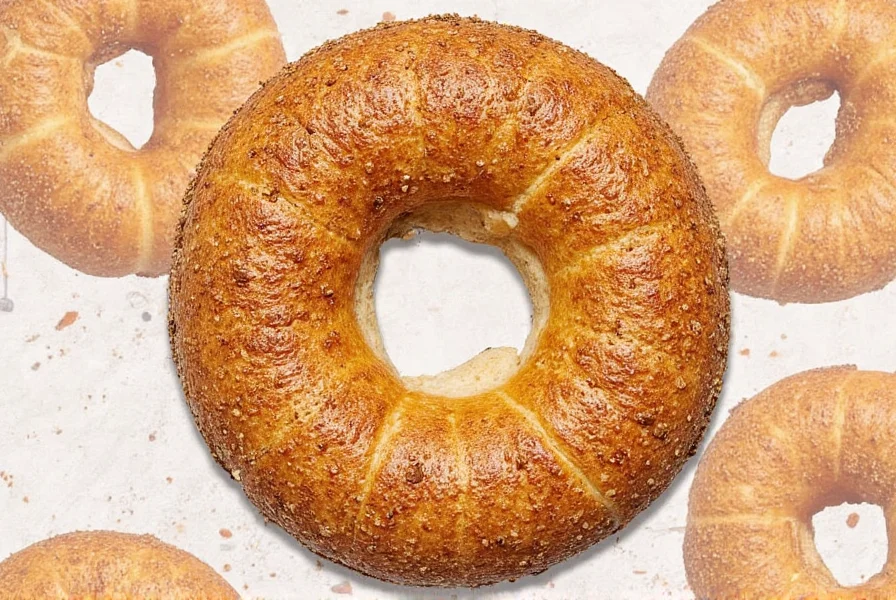Table of Contents
How to Make Bagel Seasoning
Creating authentic bagel seasoning at home is simple, cost-effective, and customizable. This essential blend enhances your bagels with savory depth and satisfying crunch. Here's the perfect recipe for homemade bagel seasoning:
- 1/4 cup coarse sea salt (provides essential flavor base)
- 2 tablespoons garlic powder (for savory depth)
- 2 tablespoons onion powder (adds sweetness and complexity)
- 1 tablespoon black pepper (for subtle heat)
- 1 tablespoon sesame seeds (crunchy texture and nutty flavor)
- 1 tablespoon poppy seeds (traditional bagel topping)
Instructions:
- Combine all ingredients in a medium bowl
- Mix thoroughly until evenly distributed
- Store in an airtight container away from heat and moisture
- For best results, make small batches (1-2 weeks supply) to maintain freshness
Variations:
- Everything Bagel Seasoning: Add 1 teaspoon dried dill and 1/2 teaspoon garlic flakes
- Spicy Version: Include 1/2 teaspoon crushed red pepper flakes
- Salt-Free Option: Replace salt with 1 tablespoon celery seed and 1 tablespoon nutritional yeast
What Is Bagel Seasoning?
Bagel seasoning is a unique blend of spices that gives bagels their signature flavor. While it might seem simple, this mix is anything but basic. It typically includes salt, garlic, onion, poppy seeds, and sesame seeds, but can vary by region or personal taste. Some versions even include dill or caraway for an extra kick.
At its core, bagel seasoning is about balance. It's not just about being spicy—it’s about enhancing the overall experience of your favorite breakfast staple. Whether you're making your own bagels or just adding a sprinkle on top, this seasoning is key to achieving that perfect bite.
Why It Matters
Bagel seasoning isn't just a flavor enhancer; it's a cultural icon. Originating from Jewish communities in New York, this blend has become a global favorite. The right amount of seasoning can make a huge difference in how your bagel tastes, so understanding it is essential for anyone who loves bagels—or wants to love them more.
But why does it matter? Because it adds texture and depth. The seeds give it a bit of crunch, while the spices provide a savory, slightly tangy finish. It's what makes your morning bagel feel like a special treat, rather than just bread with a little salt.
How to Use It
Using bagel seasoning is easy, but there are some tips to keep in mind to get the best results. Here's a quick list of practical tips:
- Use it on fresh bagels. Sprinkle it on warm, fresh-out-of-the-oven bagels for maximum flavor absorption.
- Add it to dough. If you're baking your own bagels, mixing the seasoning into the dough before shaping will ensure an even distribution.
- Experiment with different recipes. Some people like a lighter version, while others prefer a bold, spiced-up mix. Find what works for you.
- Try it on other foods. Bagel seasoning isn’t just for bagels. Try it on toast, crackers, or even salads for a unique twist.
- Store it properly. Keep your bagel seasoning in an airtight container away from heat and moisture to preserve its freshness.
Here’s a quick comparison table of different ways to use bagel seasoning:
| Usage | Description | Best For |
|---|---|---|
| On bagels | Directly sprinkled on top of baked or boiled bagels | Breakfast or snack |
| In dough | Mixed into the dough before shaping | Baked bagels |
| On toast | Added as a topping after toasting | Quick breakfast or lunch |
| On crackers | Scattered over cracker slices | Snack time or appetizers |
| In salad | Used as a dry dressing or mixed in | Salads or grain bowls |
Buying Guide
If you’re looking to buy bagel seasoning, there are several options available. Whether you prefer store-bought blends or want to make your own, here’s a detailed guide to help you choose:
1. Store-Bought Options
There are many pre-made bagel seasonings on the market. They come in various forms—some are loose, others are in shakers or jars. Look for a mix that includes salt, garlic, onion, and seeds, as these are the classic components.
Some popular brands include:
- Kraft Bagel Seasoning: A widely available option that delivers a balanced flavor. It’s great for beginners and casual users.
- Lemon Pepper & Garlic Bagel Seasoning (from local markets): This one offers a more robust flavor profile with added lemon zest for brightness.
- Homemade Blend (available online or at spice stores): Perfect for those who enjoy customizing their seasoning. You can adjust the proportions of each ingredient to suit your taste.

Each brand has its own advantages. Kraft is convenient and consistent, while homemade blends allow for greater flexibility. Consider the occasion and your personal preferences when choosing.
2. Making Your Own Bagel Seasoning
If you're a DIY enthusiast, making your own bagel seasoning is a fun and rewarding process. Here’s a simple recipe you can try:
- 1/4 cup coarse sea salt
- 2 tablespoons garlic powder
- 2 tablespoons onion powder
- 1 tablespoon black pepper
- 1 tablespoon sesame seeds
- 1 tablespoon poppy seeds
Combine all ingredients in a bowl and mix well. Store in an airtight container. This version allows you to control the strength of each component and customize it to your liking.
This blend is ideal for those who want to experiment with flavors or have dietary restrictions. It also makes a great gift for fellow foodies or bakers.
Common Mistakes to Avoid
Even seasoned bakers and chefs can make mistakes when using bagel seasoning. Here are some common errors and how to avoid them:
- Overusing it. Too much seasoning can overpower the bagel. Start with a small amount and adjust as needed.
- Using it on cold or stale bagels. Warm bagels absorb the seasoning better. Make sure your bagels are fresh and warm before applying the seasoning.
- Not storing it properly. Exposure to air and moisture can dull the flavor. Always keep your seasoning in a sealed container.
- Using it on the wrong type of bread. Bagel seasoning is specifically designed for bagels. Using it on other types of bread may not yield the same results.
- Ignoring the texture. The seeds in the seasoning add crunch. Don’t skip them if you want that satisfying bite.

By avoiding these mistakes, you can ensure that your bagels—and any other dishes you season—are as flavorful and satisfying as possible.
Frequently Asked Questions
What exactly is in traditional bagel seasoning?
Traditional bagel seasoning typically contains coarse salt, garlic powder, onion powder, sesame seeds, and poppy seeds. Some regional variations may include caraway, dill, or even crushed red pepper for additional flavor complexity.
How long does homemade bagel seasoning last?
When stored properly in an airtight container away from heat and moisture, homemade bagel seasoning will maintain optimal flavor for 6-8 months. The seeds may lose some crunch after 3-4 months, but the seasoning remains safe to use.
Can I use bagel seasoning as a meat rub?
Yes! Bagel seasoning works well as a dry rub for chicken, fish, or steak. The salt content helps form a delicious crust when searing, while the garlic and onion add savory depth. For best results, press the seasoning firmly onto the meat surface 30 minutes before cooking.
Is bagel seasoning gluten-free?
Most traditional bagel seasoning blends are naturally gluten-free since they contain only seeds, salt, and dried spices. However, always check store-bought varieties for potential cross-contamination warnings if you have severe gluten sensitivity.
Can I make a salt-free version of bagel seasoning?
Absolutely. Replace the salt with equal parts onion powder and garlic powder, plus a pinch of celery seed for depth. Add extra sesame and poppy seeds for texture. Note that without salt, the seasoning won't adhere as well to bagels, so apply it to a light coating of cream cheese or butter first.
Why does my bagel seasoning clump together?
Clumping usually occurs due to moisture exposure. To prevent this, store your seasoning with a silica gel packet in the container, or add 1 teaspoon of uncooked rice to absorb humidity. If clumping happens, break up the mixture with a fork and spread it on a baking sheet to dry for 15 minutes at 200°F.
Conclusion
Bagel seasoning is more than just a sprinkle of salt and spice—it's a crucial element that defines the character of a bagel. Whether you're a professional baker, a home cook, or just someone who loves a good breakfast, understanding and using bagel seasoning correctly can elevate your culinary experience.
The right blend of spices and seeds enhances the texture, flavor, and overall enjoyment of your bagel. And while it's often associated with breakfast, its versatility means it can be used in many other creative ways.
So next time you reach for that bagel, remember: the secret to a perfect bite might just be in the seasoning. With a little knowledge and practice, you can master the art of bagel seasoning and bring new life to your meals.
Now go ahead—sprinkle, bake, and savor the magic of bagel seasoning!











 浙公网安备
33010002000092号
浙公网安备
33010002000092号 浙B2-20120091-4
浙B2-20120091-4